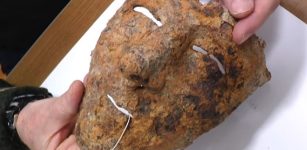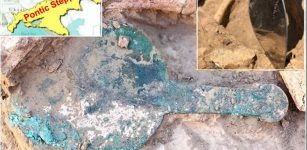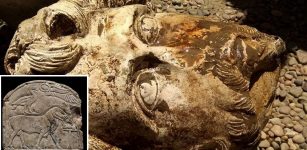Cosquer Cave And Its Magnificent Underwater Stone Age Paintings Created 27,000 Years Ago
Ellen Lloyd - AncientPages.com - Cosquer Cave is the world's only underwater Stone Age cave and a marvelous place where archaeologists have discovered mysterious paintings created by our long-gone ancestors.
Located in the Calanque de Morgiou in Marseille, France, the underwater Cosquer Cave is home to 500 extraordinary paintings and engravings. The cave drawings were made during two epochs of occupation in this part of the world. The first paintings were created 27,000 years ago; later, 19,000 years ago, cave artists produced more beautiful drawings on the walls.
The Cosquer Cave's rock art. Credit: Image compilation by AncientPages.com - original images by Archeologie Culture France.
Exploring the cave is difficult because there is only one entrance through a narrow underwater tunnel 40 meters below sea level.
The Cosquer Cave "art was preserved because the chamber happened to be high up enough not to have been flooded, but large numbers of paintings and engravings were most probably destroyed in the passage and in the lower part of the chamber.
Many other caves along that coast disappeared under the sea after the end of the Pleistocene with the rise of the water, but it is the first time ever that rock art was discovered under such circumstances." 1
The cave was accidentally discovered in 1985 by a professional Scuba diver named Henri Cosquer. Cosquer quickly understood he had found something extraordinary and kept his discovery secret for some years. Fearing the unique, ancient, underwater cave paintings would be destroyed, he only told archaeologist Jean Clotte about his discovery. The two men kept knowledge of Cosquer Cave secret for six years. Later, when the French government learned about this important archaeological and historical place, they revealed the information to the public.
Cosquer Cave Is The Only Underwater Stone Age Cave
The rock art in Cosquer Cave provided scientists with knowledge about how European Stone Age people perceived their surroundings.
Some newspapers questioned the authenticity of the paintings and engravings in the Cosquer Cave. Still, scientists later confirmed these were original drawings made by Stone Age people.
Being the only underwater Stone Age cave known to date, Cosquer Cave offers a unique glimpse into the past.
Credit: Archeologie Culture France.
The prehistoric Cosquer Cave is today a protected area open only to researchers. Nevertheless, it is naturally possible to learn what kind of paintings and engravings scientists have discovered in this submerged Stone Age realm.
"At least half the paintings are covered with patches of bright white calcite, of a type which, according to geologists, takes a very long time in depositing." 1
There are numerous paintings of different animals and engravings of hands on the cave walls.
In 1992 scientists were aware of "44 animals (21 engraved, 23 painted) and 26 negative hands, most of them with incomplete fingers, have been found. Horses are dominant (14), followed by bisons and ibex in equal numbers (7), then by chamois (5); there also are 1 red deer, 1 feline, 3 penguins, 2 seals and 2 possible megaceros, as well as 2 indeterminate quadrupeds.
Many signs, among which long barbed lines superimposed on various animals, were observed. In addition, the walls of the chamber are covered with innumerable fine engravings and finger tracings that have not so far been studied. The present count of animals, hands and signs is therefore highly provisional. The superimpositions point to two possible periods, the earlier with the negative hands and the finger tracings, the later with the painted and engraved animals and the fine engravings. "2
Today, researchers have documented as many as 500 paintings and engraving on the cave's walls.
Can Cosquer Cave's Prehistoric Rock Art Be Saved?
Scientists think it may take years before the importance of this discovery is obvious. The cave is located in a region "where no Paleolithic rock art had ever been found before." 1
According to experts, the paintings found in the Cosquer Cave exhibit various characteristics that may bear witness to outside influences.
One such place could be the Lascaux Caverns, "world-renowned for their Magdalenian paintings." 2
A replica of the Cosquer Cave is currently being created by scientists. Credit: Grotte Cosquer
Maybe there was an ancient connection between the Lascaux and Cosquer Cave painters, but each cave features its unique rock art.
Cosquer Cave's rock art has withstood the test of time, but experts warn the paintings and engravings may soon be destroyed due to climate change. We do not know if this will happen any time soon, and there is no need to panic. After all, the Cosquer Cave's rock art has survived for 27,000 years, but the future is uncertain.
To preserve the memory of our ancient ancestors and give future generations the to admire this beautiful Stone Age art, scientists and specialists are currently building a replica of the Cosquer Cave for a maritime museum in Marseille.
Updated on December 15, 2023
Written by Ellen Lloyd - AncientPages.com
Copyright © AncientPages.com All rights reserved. This material may not be published, broadcast, rewritten or redistributed in whole or part without the express written permission of AncientPages.com
Expand for references- Clottes, J., A. Beltrán, J. Courtin, and H. Cosquer. "La Grotte Cosquer (Cap Morgiou, Marseille)." Bulletin De La Société Préhistorique Française89, no. 4 (1992): 98-128.
- Clottes J. & Courtin J - The Cave Beneath the Sea
More From Ancient Pages
-
 Oldest Greek Oracle At Dodona And Zeus Sacred Oak Tree – Where Oracle of Dodona: Sacred Place Where Gods Spoke To Humans For The First Time
Featured Stories | May 24, 2016
Oldest Greek Oracle At Dodona And Zeus Sacred Oak Tree – Where Oracle of Dodona: Sacred Place Where Gods Spoke To Humans For The First Time
Featured Stories | May 24, 2016 -
 Thermopolium – Ancient Roman Restaurant Offered Fast Food But Was It A Good Idea To Eat There?
Ancient History Facts | Mar 16, 2018
Thermopolium – Ancient Roman Restaurant Offered Fast Food But Was It A Good Idea To Eat There?
Ancient History Facts | Mar 16, 2018 -
 Has The Mystery Of The Hobbits Finally Been Solved?
Archaeology | Apr 21, 2017
Has The Mystery Of The Hobbits Finally Been Solved?
Archaeology | Apr 21, 2017 -
 Extremely Rare Roman Cavalry Parade Mask Discovered In Romania
Archaeology | Feb 8, 2023
Extremely Rare Roman Cavalry Parade Mask Discovered In Romania
Archaeology | Feb 8, 2023 -
 Cities Of Bashan Were Built By Ancient Giants – Archaeological Evidence Exists But Is Ignored
Biblical Mysteries | Nov 25, 2020
Cities Of Bashan Were Built By Ancient Giants – Archaeological Evidence Exists But Is Ignored
Biblical Mysteries | Nov 25, 2020 -
 Who Is Buried In The Extremely Well-Preserved 2,600-Year-Old Celtic Chamber Tomb Found Near Riedlingen, Germany?
Archaeology | Oct 24, 2024
Who Is Buried In The Extremely Well-Preserved 2,600-Year-Old Celtic Chamber Tomb Found Near Riedlingen, Germany?
Archaeology | Oct 24, 2024 -
 Struggle To Get Mail On Time Has Lasted More Than 5,000 Years – Part 2
Featured Stories | Jul 31, 2017
Struggle To Get Mail On Time Has Lasted More Than 5,000 Years – Part 2
Featured Stories | Jul 31, 2017 -
 Mystery Of The Scientist Who ‘Saw’ A Fire From Miles Away
Featured Stories | Nov 1, 2020
Mystery Of The Scientist Who ‘Saw’ A Fire From Miles Away
Featured Stories | Nov 1, 2020 -
 Scythians Were Not Always Nomadic Warriors Of The Pontic Steppe In Black Sea Region
Archaeology | Mar 19, 2021
Scythians Were Not Always Nomadic Warriors Of The Pontic Steppe In Black Sea Region
Archaeology | Mar 19, 2021 -
 Earliest Baltic Amber In Western Europe Found On The Iberian Peninsula 5,000 Years Ago
Archaeology | Oct 21, 2023
Earliest Baltic Amber In Western Europe Found On The Iberian Peninsula 5,000 Years Ago
Archaeology | Oct 21, 2023 -
 Surprising Discovery – Replica In The Field Museum Is A 3,000-Year-Old Sword
Artifacts | Jan 18, 2023
Surprising Discovery – Replica In The Field Museum Is A 3,000-Year-Old Sword
Artifacts | Jan 18, 2023 -
 Incredible CT scans show Pompeii victims ‘in good health’
Civilizations | Oct 3, 2015
Incredible CT scans show Pompeii victims ‘in good health’
Civilizations | Oct 3, 2015 -
 Ancient Shrine Of God Osiris-Ptah Neb And Rare Bust Of Emperor Marcus Aurelius Discovered In Egypt
Archaeology | Apr 28, 2018
Ancient Shrine Of God Osiris-Ptah Neb And Rare Bust Of Emperor Marcus Aurelius Discovered In Egypt
Archaeology | Apr 28, 2018 -
 120,000-Year-Old Bone Etchings – Evidence Of The Earliest-Known Use Of Symbols
Archaeology | Feb 3, 2021
120,000-Year-Old Bone Etchings – Evidence Of The Earliest-Known Use Of Symbols
Archaeology | Feb 3, 2021 -
 On This Day In History: Sverre Sigurdsson Became King Of Norway – On June 29, 1194
News | Jun 29, 2016
On This Day In History: Sverre Sigurdsson Became King Of Norway – On June 29, 1194
News | Jun 29, 2016 -
 Unusual Neolithic Burial From Grotta Di Pietra Sant’ Angelo Puzzles Archaeologists
Featured Stories | Jan 15, 2024
Unusual Neolithic Burial From Grotta Di Pietra Sant’ Angelo Puzzles Archaeologists
Featured Stories | Jan 15, 2024 -
 Mysterious Mongolian Arc Investigated By Scientists
Archaeology | Jan 2, 2024
Mysterious Mongolian Arc Investigated By Scientists
Archaeology | Jan 2, 2024 -
 ‘Impossible’ Ancient Knowledge Of The Gods’ Star – First Observations – Part 1
Ancient Mysteries | Aug 29, 2021
‘Impossible’ Ancient Knowledge Of The Gods’ Star – First Observations – Part 1
Ancient Mysteries | Aug 29, 2021 -
 Egyptian Artisans In The Valley Of The Kings Had Permanent Jobs In The Time Of The Pharaohs
Featured Stories | Apr 11, 2022
Egyptian Artisans In The Valley Of The Kings Had Permanent Jobs In The Time Of The Pharaohs
Featured Stories | Apr 11, 2022 -
 On This Day In History: Battle Of San Domingo Was Fought – On February 6, 1806
News | Feb 6, 2017
On This Day In History: Battle Of San Domingo Was Fought – On February 6, 1806
News | Feb 6, 2017



